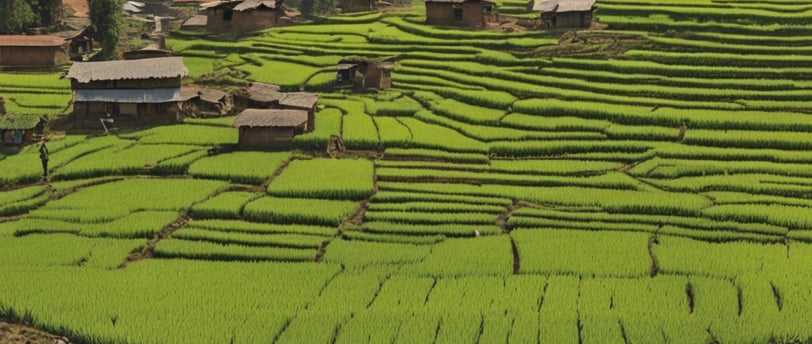Agricultural Economics and Policy for Data-Driven Farming in Nepal Using Agera
Nepal’s agricultural sector is vital for the economy, providing employment to nearly two-thirds of the population and contributing significantly to the country’s GDP. However, the sector faces several challenges, including low productivity, resource inefficiency, and vulnerability to climate change. Traditional farming methods, while steeped in historical knowledge, are no longer sufficient to meet the demands of modern agriculture. A data-driven farming system, like Agera, offers a solution by enabling precision farming and optimizing resource use. This shift towards data-driven farming requires not only the adoption of new technologies but also supportive agricultural policies and economic frameworks to ensure its success. In this blog, we explore the economic implications and policy considerations necessary for promoting data-driven farming systems like Agera in Nepal.
10/2/20244 min read


Economic Benefits of Data-Driven Farming
Data-driven farming systems like Agera bring a wealth of economic advantages to farmers and the broader agricultural sector. By leveraging real-time data on soil moisture, temperature, nutrient levels (NPK), and other key environmental factors, farmers can make more informed decisions that improve efficiency, increase yields, and reduce input costs. Here are the key economic benefits of adopting such systems:
Increased Productivity Data-driven farming leads to higher productivity by optimizing resource use. Farmers can irrigate more efficiently, apply fertilizers at the right time and in the correct amounts, and manage pests and diseases more effectively. These actions lead to healthier crops and higher yields, which directly translate to increased income for farmers.
Cost Reduction Agera’s system helps farmers reduce costs by minimizing waste. For example, instead of over-irrigating fields, farmers can use precise data on soil moisture to apply just the right amount of water, reducing water bills and conserving resources. Similarly, data on soil nutrient levels allows for targeted fertilization, saving money on unnecessary inputs.
Improved Resource Allocation The efficiency brought by data-driven systems enables farmers to better allocate their resources. With insights into soil health, weather patterns, and crop performance, farmers can decide which crops to plant, how much land to allocate, and when to rotate crops. This strategic use of resources maximizes profitability while ensuring long-term sustainability.
Risk Mitigation Agriculture is a risky business, especially in Nepal, where farmers are vulnerable to unpredictable weather patterns, pests, and market fluctuations. Data-driven systems like Agera provide early warning alerts for potential risks such as drought, pests, or nutrient deficiencies. By taking preventive action based on these alerts, farmers can avoid crop losses and stabilize their income.
Market Competitiveness Data-driven farming enables farmers to produce higher-quality crops, which can be sold at premium prices in the market. Additionally, with better planning and resource management, farmers can produce more consistently, allowing them to meet market demand more reliably. This strengthens their competitive position, both in local and international markets.
Policy Considerations for Promoting Data-Driven Farming
While the economic benefits of data-driven farming are clear, realizing these benefits on a large scale requires supportive government policies and institutional frameworks. Here are the key policy areas that need to be addressed to promote the adoption of systems like Agera in Nepal:
Subsidies and Financial Incentives Data-driven farming technologies can be costly for smallholder farmers to adopt. Governments can offer subsidies or financial incentives to reduce the initial cost of purchasing and installing sensor-based systems like Agera. These incentives could take the form of direct subsidies, low-interest loans, or grants aimed at promoting precision agriculture.
By reducing the financial barrier to entry, the government can encourage more farmers to adopt data-driven practices, leading to long-term economic gains for both individual farmers and the nation.
Training and Capacity Building The adoption of data-driven farming systems requires a skilled workforce that can operate and maintain the technology. Governments, in collaboration with agricultural organizations and NGOs, should provide training and capacity-building programs for farmers. These programs should focus on:
Understanding how to use and interpret data collected by sensor systems.
Implementing precision farming techniques based on the data.
Maintaining and troubleshooting the technology to ensure its longevity.
Education and extension services are critical to ensuring that farmers can fully realize the benefits of data-driven systems like Agera.
Infrastructure Development Data-driven farming systems rely on stable internet connectivity and access to digital platforms for transmitting data and receiving insights. The government needs to invest in rural digital infrastructure, ensuring that even farmers in remote areas can access the benefits of systems like Agera. This could include expanding broadband internet coverage, providing mobile data services, and improving rural electricity supply to support the use of modern technologies.
Research and Development (R&D) Continuous innovation is key to the success of data-driven farming. Governments should invest in R&D to develop new sensors, software, and algorithms that are tailored to the specific needs of Nepal’s diverse agricultural landscape. Collaborations between government research institutions, universities, and the private sector can drive innovation in precision agriculture and ensure that farmers have access to the latest advancements.
R&D should also focus on testing and improving existing systems like Agera to ensure they are optimized for different types of crops, soil conditions, and climates in Nepal.
Agricultural Insurance and Risk Management Even with the benefits of data-driven farming, agriculture remains a risky endeavor. Governments can promote agricultural insurance schemes that cover crop losses due to unpredictable events like floods, droughts, or pest infestations. By incorporating data from systems like Agera, insurers can offer tailored coverage that reflects the actual risks faced by farmers, leading to fairer premiums and more comprehensive coverage.
Integrating data-driven insights into risk management strategies can help stabilize farm incomes and encourage more farmers to adopt modern farming practices.
Market Access and Supply Chain Integration For farmers to fully benefit from increased productivity, they need access to markets where they can sell their crops at fair prices. Governments should support initiatives that connect smallholder farmers to local, regional, and international markets. This can be done through:
Developing agricultural cooperatives and farmer collectives.
Investing in transportation and logistics infrastructure to reduce post-harvest losses.
Providing market information systems that use data to help farmers plan production according to market demand.
By improving market access, farmers can capitalize on the higher yields produced by data-driven farming and increase their profitability.
Conclusion: The Way Forward for Nepal’s Agricultural Sector
Agera’s data-driven farming system represents a significant opportunity to modernize agriculture in Nepal, making it more efficient, sustainable, and resilient. However, to fully realize the potential of such systems, the right economic and policy frameworks need to be in place. Governments, research institutions, and the private sector must collaborate to create an enabling environment where farmers can adopt and benefit from modern technologies.
With the right mix of subsidies, training, infrastructure development, and market access, data-driven farming can become the cornerstone of Nepal’s agricultural transformation. By embracing these changes, Nepal can ensure food security, boost rural incomes, and create a more sustainable agricultural future.



